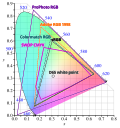Gamut
In computer graphics and photography, the gamut, or color gamut /ˈɡæmət/, is a certain subset of colors. Most often it is a subset of colors, which can be accurately represented by some output device.
Another sense refers to the complete set of colors found within an image.
Introduction
The term gamut was adopted from music, where in middle age Latin "gamut" meant the entire range of musical notes of which musical melodies are composed. In the 1850s, the term was used for a range of colors or hue, for example by Thomas De Quincey, who wrote "Porphyry, I have heard, runs through as large a gamut of hues as marble."[1]
In color theory, the gamut of a device is the portion of the color space that it can show.
When certain colors cannot be presented within a particular color model, those colors are said to be out of gamut.
While processing a digital image, an image is usually recorded in RGB color model. When printing such image has to be converted from an original RGB color space to the printer's CMYK color space. During this process, the colors, which are out of printer's gamut are converted to the in-gamut colors. So, the final image is an approximation of the original one.
Representation of gamuts
Gamuts are commonly represented as areas in the full visible range of colors. The full range of colors is usually shown as CIE 1931 chromaticity diagram shaped like a horseshoe.
The gamut depends on the brightness. So a full gamut is represented in 3D space.
Comparison of gamut of some devices
The list contains some typical devices, wich show pictures, ranging from large to small color gamut:
- Laser video projector uses three lasers to produce the broadest gamut available today. Because lasers produce truly monochromatic primaries. More than three lasers can be used together to increase the gamut range.
- Photographic film can reproduce a larger color gamut than typical television or computer.[2]
- CRT displays have a roughly triangular color gamut, which covers a large portion of the visible color space. In CRTs, the limitations are due to the phosphors in the screen which produce red, green, and blue light.
- Printing typically uses the CMYK color space (cyan, magenta, yellow, and black). Efforts have been made to expand the gamut of the printing process by adding inks of non-primary colors.
- A monochrome display's color gamut is a one-dimensional curve in color space.[3]
Gamut Media
The visible gamut plotted within the CIELUV color space using D65 whitepoint. u and v are the horizontal axes; L is the vertical axis.
MacAdam limits for illuminant CIE F4 in CIE xyY color space
References
- ↑ Thomas De Quincey (1854). De Quincey's works. James R. Osgood. p. 36.
gamut-of-hues 0-1856.
- ↑ "Film gamut, apples, and oranges". Archived from the original on 2008-09-17. Retrieved 2007-04-26.
- ↑ Velho, Luiz; Frery, Alejandro C.; Gomes, Jonas (2009-04-29). Image Processing for Computer Graphics and Vision. Springer Science & Business Media. ISBN 9781848001930.
Other websites
- Using the Chromaticity Diagram for Color Gamut Evaluation by Bruce Lindbloom.
- Color Gamut Mapping[dead link] book by Jan Morovic.
- Quantifying Color Gamut by William D. Kappele
- Stanford University CS 178 interactive Flash demo explaining color gamut mapping.





